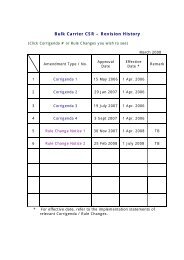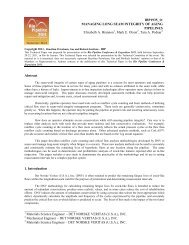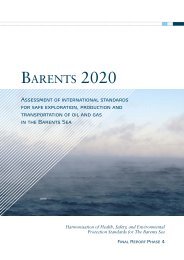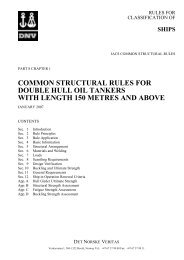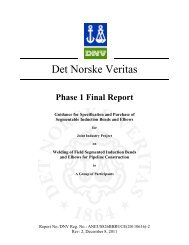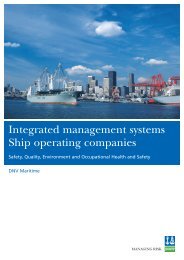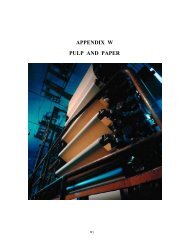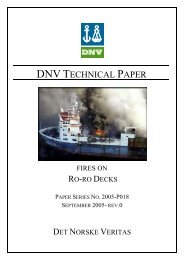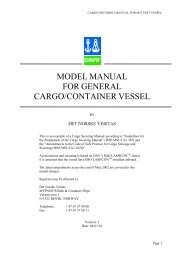InSitu Analysis of Pipeline Metallurgy - dnV
InSitu Analysis of Pipeline Metallurgy - dnV
InSitu Analysis of Pipeline Metallurgy - dnV
You also want an ePaper? Increase the reach of your titles
YUMPU automatically turns print PDFs into web optimized ePapers that Google loves.
careful removal <strong>of</strong> coating and close visual examination <strong>of</strong> the area near girth welds will sometimesreveal the stamp marks.Girth weld joint designs and weld metal appearance are not frequently characterized during directexamination but they can be significant from the standpoint <strong>of</strong> assessing likely resistance to large axialstrains such as those associated with ground deformation. Reference 5 describes the evolution <strong>of</strong>several different types <strong>of</strong> girth weld joint designs. For example, fillet welded bell+spigot joint designswere largely abandoned in the early 1930s in part because <strong>of</strong> the relatively low axial strain capacity <strong>of</strong>the fillet welds. In comparison, the bell-bell-chill ring (BBCR) joint design that followed was found tohave much better strain capacity, even when workmanship was imperfect.Oxyacetylene weld deposits are notorious for having workmanship flaws in the weld root and <strong>of</strong>tenhave a uniquely high and wide cap on the OD surface. While the dimensions <strong>of</strong> the weld cap areseldom measured in the course <strong>of</strong> routine bellhole inspection, it has been demonstrated that very widecaps (width at least five time the wall thickness) having a height greater than 50% <strong>of</strong> the wall thicknessreduce the applied stress intensity factor by a minimum <strong>of</strong> 25%. Smaller caps have smaller influencewith the effect being related to cap height to width ratio and dimensions relative to the pipe wallthickness. As a result, the strain capacity <strong>of</strong> the welds can be somewhat larger than what is expectedbased on conventional fracture mechanics evaluations that disregard the cap effects. 6 Therefore,recording the dimensions <strong>of</strong> weld caps can support fitness for service assessments <strong>of</strong> welds.One typically overlooked feature <strong>of</strong> early girth welds is the consistency <strong>of</strong> the weld metal ripple patternthat indicates the direction <strong>of</strong> weld progression. Early pipeline construction techniques included thepractice <strong>of</strong> making several girth welds above ground while pipe was rolled underneath the welding arcor torch. Segments <strong>of</strong> welded pipe were then placed into the ditch and welded together in the morechallenging fixed position. Sometimes different welding processes were used for the two different types<strong>of</strong> welds. The rolled position and fixed position welds result in different weld ripple patterns that areeasily distinguishable from each other. In more modern pipe similar weld to weld variations inworkmanship and properties exist when pipe segments are made using pipe that is “double jointed”,typically using submerged arc welding, at the mill prior to being delivered to the construction site. As aresult <strong>of</strong> the two different welding positions and/or use <strong>of</strong> different welding processes for different girthwelds the long pipeline segments can have two (or more) distinctly different populations <strong>of</strong> girth welds.Each weld population can have different workmanship quality and mechanical properties that occurrepeated sequences. Identifying the presence <strong>of</strong> multiple populations <strong>of</strong> girth welds can influenceintegrity assessment sampling plans and assessment methodologies.Sometimes visual examination must be supplemented with NDT to differentiate among seam types.For example, single side submerged arc welded (SSAW) and double sided submerged arc welded(DSAW or SAW-L) seams look the same from the OD surface. Only the ID appearance is different.Normally, the differences are apparent in radiographic inspection.In another example, two separate types <strong>of</strong> seams are commonly mischaracterized as a product <strong>of</strong> anearly submerged arc welding process when in fact they are both unique types <strong>of</strong> seams manufacturedfrom about 1928 to 1932 by A.O. Smith Corporation. (1) The external appearance <strong>of</strong> both types <strong>of</strong>seams is the same as a result <strong>of</strong> both types using a relatively broad, flat cap pass <strong>of</strong> metal deposited byshielded metal arc welding (Figure 3). In both types <strong>of</strong> seams weld metal solidification cracks are <strong>of</strong>tenfound in the cap pass. Until 1930 the seam consisted only <strong>of</strong> multiple passes <strong>of</strong> weld metal depositedby shielded metal arc welding process. Incomplete penetration and lack <strong>of</strong> fusion in the root region iscommonly observed. By 1930 the root portion <strong>of</strong> the seam was first formed by the flash weld processand the cap pass was used only for additional reinforcement. As a result, the OD <strong>of</strong> the pipe isindistinguishable from the earlier vintage pipe while the ID looks like a conventional flash welded seam.1 Trade name.





